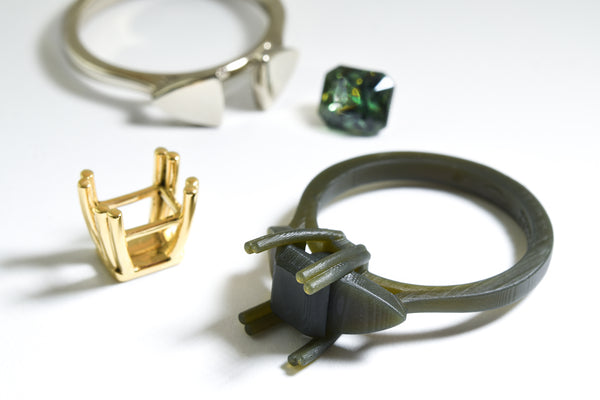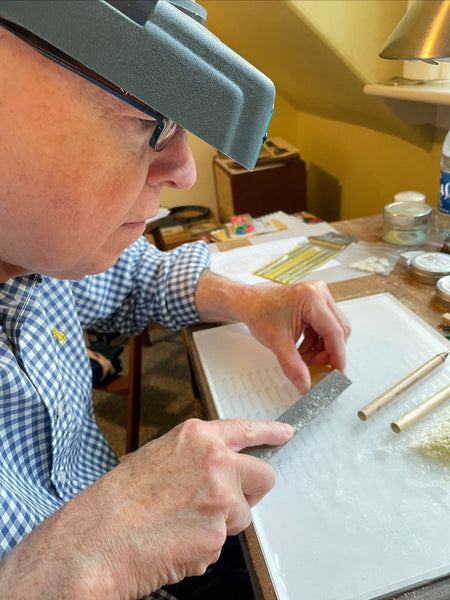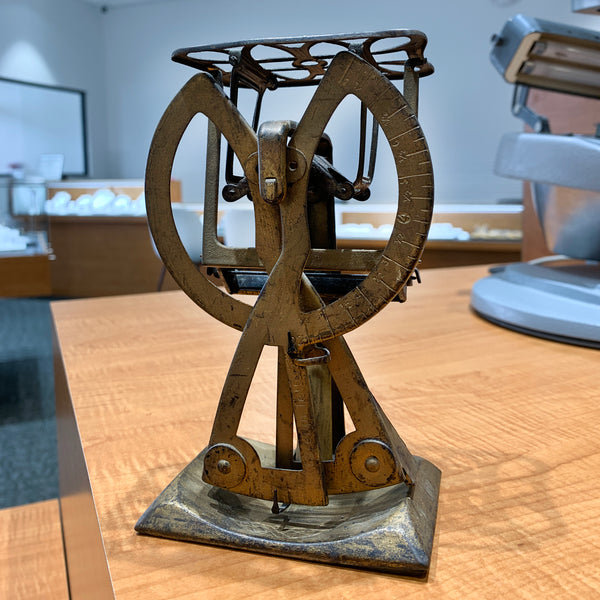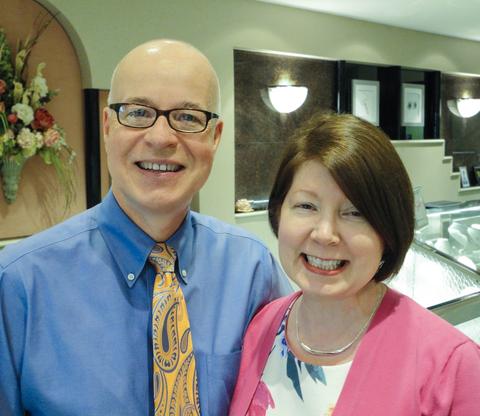April Birthstone Jewelry: The History of Diamonds and How to Care for Yours

If you were born in April, you have the most prized birthstone of all: the diamond. It is a gem of enduring symbolism and meaning, as well as a stunning fashion accent. The April birthstone has a long history as a gorgeous object of desire that goes back thousands of years. Representing power, beauty, wealth, and affluence, diamonds truly are extraordinary.
It’s a well-known fact that diamonds are bright, white, and sparkly. Yet there is so much more to learn about this fascinating gemstone! Let’s take a look at the history of the diamond, diamond jewelry tips, and other facts about April birthstone jewelry.

Diamond History and Lore
Diamonds are considered to be one of the most valuable objects in the world. The hardest natural substance known to man, diamonds were formed over 3 billion years ago. As the molten Earth was cooling from its cosmic beginnings, diamonds formed deep within the Earth’s crust under intense pressure and heat. They were pushed up to the Earth’s surface, waiting to be mined or naturally extracted.
There is a lot of work involved in turning mined diamonds into the beautiful treasures we enjoy. Once they are mined, they are cut and polished until their natural brilliance comes through. Diamond is the hardest gemstone. White diamonds are the only gemstone made of a single element: pure carbon. Traces of other elements create the color in natural-colored diamonds.
The first diamond is believed to have been discovered in India around 2500 BC, mostly found around the country’s rivers. Back then, they weren’t valued for their brilliance and beauty. Instead, diamonds were used as tools because of their hardness and indestructibility.
As early as 400 BC, the gems were being traded in India. There were limited quantities of diamonds, and they were reserved for India’s very wealthy classes. The ancient Greeks believed that diamonds were tears from the Gods. The word diamond comes from a Greek word adamas, which means indestructible and unconquerable.
Diamonds have always been a symbol of wealth and prosperity, worn by the powerful for invincibility. They were considered to be mystical gems that held a special power for kings and queens, and affected the heavens and hearts. In Sanskrit, the diamond is called vajra, which means lightning. Vajra was the weapon of Indra, the king of gods in Hindu mythology. Diamonds also stood for eternal and lasting love, and still do to this day.
Diamonds were first used as decoration around 300 BC. They were reserved only for kings and symbolized strength and courage. By the 1400s, diamonds were valued and traded in Europe, and became fashionable jewelry for the elite. In 1477, Archduke Maximilian of Austria was the first to give a diamond as an engagement ring—he proposed to Mary of Burgundy with a diamond ring that symbolized his betrothal. She wore the ring on the third finger of her right hand, next to a vein that goes directly to the heart.
During the 1600s, diamonds remained a symbol of wealth and were worn by prosperous men and women in Europe. The first South African diamond deposits were unearthed in the late 1800s, just in time for the increasing demand for diamonds in a time of affluence.
In modern times, diamonds are more commonly worn. They have been traditionally used as engagement rings since the 1900s. During the Golden Age of Hollywood, diamonds became a status symbol for the movie industry’s most glamorous actresses. Many film stars wore their own diamonds on screen. In 1953, Marilyn Monroe performed “Diamonds are a Girl’s Best Friend” in the movie Gentlemen Prefer Blondes, encouraging love for the gemstone.

Diamonds: Things to Consider
Whether you’re getting engaged, celebrating an April birthday or a 60th/75th wedding anniversary, or desiring a stunning piece for yourself, giving a diamond means giving a perfectly beautiful gift that will truly stand the test of time. Here are some things to consider as you think about your next adventure with a new diamond piece:
- Diamonds come in several colors, including yellow, red, pink, blue, and green. However, these naturally-colored diamonds are rare. For these fancy colored diamonds, the more saturated the color, the higher the value. It is rarer to find a diamond that is colorless than it is to find one that has a slight yellow or gray tint. This means that a colorless diamond is more expensive.
- Diamond prices are related to rarity and inclusions. An inclusion is an imperfection formed in the diamond. A diamond with few or no inclusions is more rare than one that has inclusions, so its price is higher. It is also more rare to find a beautiful diamond in a larger size than in a smaller size. A one-carat diamond will be more expensive than two half-carat diamonds.
- Vintage diamond jewelry is often more affordable than new jewelry and offers interesting designs from different eras.
- Diamonds are usually set in gold or platinum. Sterling silver is sometimes used for fashion jewelry. (Larger, more valuable diamonds are not typically set in silver since it is not as strong as other metals.)
- Even on a relatively inexpensive piece of diamond jewelry, you should not be able to feel roughness or sharpness when you run your fingers over the diamond settings. When you turn the jewelry to catch the light, the rows of diamonds should flash evenly.
- When creating jewelry, you can mix less-expensive gemstones, such as amethyst or blue topaz, with diamonds. The colored gem can be larger and surrounded by tiny diamonds to give a little pop and sparkle to the piece.

How to Wear and Care for Diamond Jewelry
- Because of its neutral color, a diamond is the easiest birthstone to wear—it goes with everything! Its hardness also makes it easy to wear every day, without too much worry about damage.
- Diamonds are cut with facets (small planes that reflect light) in order to create sparkle. In fact, they are so sparkly that even a small diamond will enhance a piece of jewelry.
- Although diamonds can be chipped or fractured, this rarely happens. Most damage to diamond jewelry involves wear and tear on the settings, which causes diamonds to fall out.
- Avoid wearing diamond jewelry to do heavy housework, gardening, or outdoor activities.
- Repeated exposure to chlorine in pools or household cleaners will cause damage to the alloys in white gold, and can cause the loss of diamonds.
- Clean diamond jewelry frequently to keep the diamonds as sparkly as possible. Brush the diamonds, including underneath them, with a soft toothbrush and dish detergent in water.
- If you prefer to use a commercial jewelry cleaner, follow the instructions. Don’t soak your jewelry in it, and be sure to rinse well.
- Combine diamonds with freshwater pearls for a contrast of sparkle and the satiny surface of the pearls.
- Classic diamond jewelry, such as diamond stud earrings, will never go out of style. They will be worn for years to come and even by future generations.
- Have your rings checked every few months—a good jeweler will check the settings for free and clean your diamonds as well.
In the market for a diamond for you or a loved one? Be sure to check out our blog next month—we’ll talk about diamond shopping tips and how to get the best diamond for your budget.
Plante Jewelers offers a wonderful selection of diamonds and lovely April birthstone jewelry to match your personal style. Visit our store in Swansea to check out our collections, or create your own personalized designs. We’ll help you find or create the best option for you or a loved one.
2 Responses
Nancy Plante
Hi, For your October birthday you can wear opals or tourmalines. Tourmaline comes in several different colors. Here’s an article about the birthstones for October: https://www.plantejewelers.com/blogs/general-blog/october-birthstones-what-you-need-to-know-about-opal-tourmaline-jewelry
—Nancy
Mahantesh nyamagoudar
My birth date 10/4/1979. 9-30am birth place Bagalkot Karnataka India which gemstone suitable for me please advise me sir Thankyou
Leave a comment
Comments will be approved before showing up.






Nancy Plante
Author